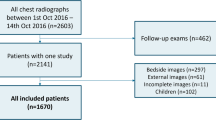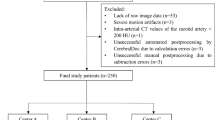Abstract
The convenience of a computed tomography (CT) scanner in the emergency department (ED) may impact utilization rates. Our primary aim was to determine the rate of utilization before and after the placement of an ED CT scanner. Secondary aims were to determine the rate of utilization by anatomic region and during a 5-month period when the ED scanner was unavailable. We performed an electronic chart review of our ED with an annual census of 70,000 patients. We identified all patients over the age of 21 who had a CT scan performed from January 2008 to October 2010. Predetermined data elements were extracted by trained, hypothesis-blinded abstractors. Comparisons overall and within scan subtype were performed using seasonal matching. We found a CT utilization rate of 114 per 1,000 patient visits before and 139 per 1,000 patient visits after the placement of a CT scanner in the ED (p < 0.0001). Linear regression analysis found a line with a slope of β = 0.114 (95 % CI = 0.107–0.121) and an R2 of 0.508. CT rates increased in the following regions: head CTs by 14 per 1,000 visits (p < 0.0001); neck CTs by 3 per 1,000 visits (p < 0.0001); abdomen/pelvis CTs by 4 per 1,000 visits (p = 0.0015); “other” CTs by 2 per 1,000 visits (p < 0.0001). Increased rates of chest and facial CTs approached significance with p values of 0.05. During the 5-month downtime, utilization remained unchanged at 141 per 1,000 visits (p = 0.38). Overall CT utilization increased after the placement of a scanner in the ED. Most subtypes of scan increased. Utilization was unchanged during a period of ED scanner unavailability, suggesting that increased utilization may be difficult to reverse.


Similar content being viewed by others
References
Lee J et al (2010) Computed tomography use in the adult emergency department of an academic urban hospital from 2001 to 2007. Ann Emerg Med 56:591–596. doi:10.1016/j.annemergmed.2010.05.027
Boone JM, Brunberg JA (2008) Computed tomography use in a tertiary care university hospital. J Am Coll Radiol JACR 5:132–138. doi:10.1016/j.jacr.2007.07.008
Broder J, Warshauer DM (2006) Increasing utilization of computed tomography in the adult emergency department, 2000–2005. Emerg Radiol 13:25–30. doi:10.1007/s10140-006-0493-9
Broder J, Fordham LA, Warshauer DM (2007) Increasing utilization of computed tomography in the pediatric emergency department, 2000–2006. Emerg Radiol 14:227–232. doi:10.1007/s10140-007-0618-9
Broder JS (2008) CT utilization: the emergency department perspective. Pediatr Radiol 38(Suppl 4):S664–S669. doi:10.1007/s00247-008-0892-z
Sosna J, Slasky BS, Bar-Ziv J (1997) Computed tomography in the emergency department. Am J Emerg Med 15:244–247
Oguz KK, Yousem DM, Deluca T, Herskovits EH, Beauchamp NJ (2002) Effect of emergency department CT on neuroimaging case volume and positive scan rates. Acad Radiol 9:1018–1024
Lee J et al (2013) Head computed tomography utilization and intracranial hemorrhage rates. Emerg Radiol 20:219–223. doi:10.1007/s10140-012-1098-0
Korley FK, Pham JC, Kirsch TD (2010) Use of advanced radiology during visits to US emergency departments for injury-related conditions, 1998–2007. JAMA J Am Med Assoc 304:1465–1471. doi:10.1001/jama.2010.1408
Rao VM, Levin DC, Parker L, Frangos AJ, Sunshine JH (2011) Trends in utilization rates of the various imaging modalities in emergency departments: nationwide Medicare data from 2000 to 2008. J Am Coll Cardiol 8:706–709. doi:10.1016/j.jacr.2011.04.004
Zhou JC et al (2012) Trends in computed tomography utilization and association with hospital outcomes in a Chinese emergency department. PloS one 7:e40403. doi:10.1371/journal.pone.0040403
Brenner DJ, Hall EJ (2007) Computed tomography—an increasing source of radiation exposure. N Engl J Med 357:2277–2284. doi:10.1056/NEJMra072149
Kirsch TD, Hsieh YH, Horana L, Holtzclaw SG, Silverman M, Chanmugam A (2011) Computed tomography scan utilization in emergency departments: a multi-state analysis. J Emerg Med 41(3):302–309. doi:10.1016/j.jemermed.2010.06.030
Shah, K. H. et al. (2013) Radiation exposure among patients with the highest CT scan utilization in the emergency department. Emergency radiology, doi:10.1007/s10140-013-1142-8
Chen JL, Dorfman GS, Li MC, Cronan JJ (1996) Use of computed tomography scanning before and after sitting in an emergency department. Acad Radiol 3:678–682
Romano S, Romano L (2010) Utilization patterns of multidetector computed tomography in elective and emergency conditions: indications, exposure risk, and diagnostic gain. Seminars Ultrasound CT MR 31:53–56. doi:10.1053/j.sult.2009.10.002 (2010)
Donohoo JH, Mayo-Smith WW, Pezzullo JA, Egglin TK (2008) Utilization patterns and diagnostic yield of 3421 consecutive multidetector row computed tomography pulmonary angiograms in a busy emergency department. J Comput Assist Tomogr 32:421–425. doi:10.1097/RCT.0b013e31812e6af3
Berdahl, C. T., Vermeulen, M. J., Larson, D. B. & Schull, M. J. (2013) Emergency department computed tomography utilization in the United States and Canada. Annals of emergency medicine, doi:10.1016/j.annemergmed.2013.02.018
Lee CI et al (2012) Ordering of CT by emergency department provider type: analysis of a nationally representative sample. AJR Am J Roentgenol 199:1054–1059. doi:10.2214/ajr.11.8303
Weiss CR et al (2006) CT pulmonary angiography is the first-line imaging test for acute pulmonary embolism: a survey of US clinicians. Acad Radiol 13:434–446. doi:10.1016/j.acra.2006.01.002
Ahmed, F., Zafar, A. M., Khan, N., Haider, Z. & Ather, M. H. (2010) A paradigm shift in imaging for renal colic—is it time to say good bye to an old trusted friend? International journal of surgery (London, England) 8, 252–256, doi:10.1016/j.ijsu.2010.02.005
Bailitz J et al (2009) CT should replace three-view radiographs as the initial screening test in patients at high, moderate, and low risk for blunt cervical spine injury: a prospective comparison. J Trauma 66:1605–1609. doi:10.1097/TA.0b013e3181a5b0cc
Mathen R et al (2007) Prospective evaluation of multislice computed tomography versus plain radiographic cervical spine clearance in trauma patients. J Trauma 62:1427–1431. doi:10.1097/01.ta.0000239813.78603.15
Brenner DJ, Elliston CD (2004) Estimated radiation risks potentially associated with full-body CT screening. Radiology 232:735–738. doi:10.1148/radiol.2323031095
Acknowledgments
We would like to acknowledge the efforts of Andrea Wood and Avah Mealy whose technical expertise with the electronic medical record made this paper possible.
Conflict of interest
The authors declare that they have no conflict of interest.
Author information
Authors and Affiliations
Corresponding author
Rights and permissions
About this article
Cite this article
Runde, D., Shah, K., Naraghi, L. et al. Computed tomography utilization rates after the placement of a scanner in an emergency department: a single-center experience. Emerg Radiol 21, 473–478 (2014). https://doi.org/10.1007/s10140-014-1217-1
Received:
Accepted:
Published:
Issue Date:
DOI: https://doi.org/10.1007/s10140-014-1217-1




